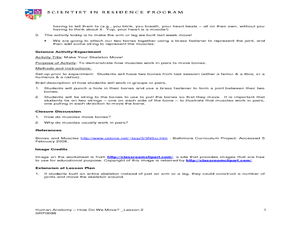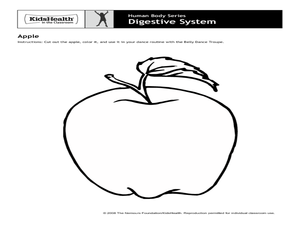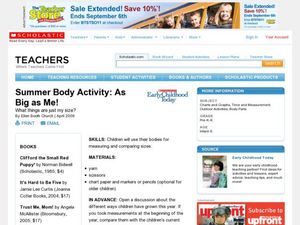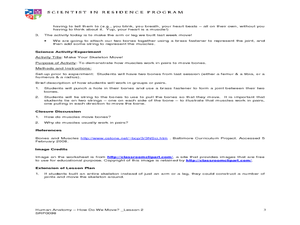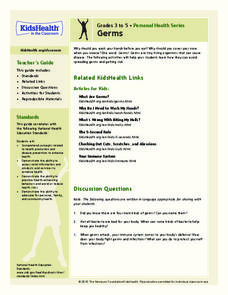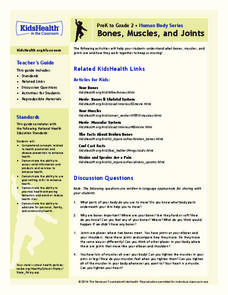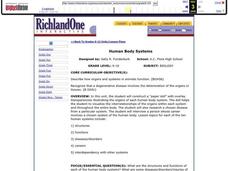Curated OER
Human Body Corp.
Learners investigate body systems by participating in a role-play activity. Third, fourth, and fifth graders pretend that they are an organ or system of the human body, and they must write a letter to the body "corporation" discussing...
Curated OER
Human Anatomy- How Do We Move?
Students explore the human anatomy. In this respiratory system lesson plan, students conduct an experiment to simulate the capacity of human lungs.
Curated OER
Human Anatomy -- How Do We Move?
Students create a model of the digestive system. In this human anatomy lesson the students examine features of the digestive system. The students perform an experiment.
Curated OER
Human Body Series - Digestive System
With articles entitled, "What's Puke?" and "What is a Fart?" this digestive system lesson is sure to be a gas! Elementary anatomists do a belly dance to illustrate how food moves through the digestive system and then design a board game...
Curated OER
Human Body Simon Says
Learners display their new knowledge of human body parts' names and locations, by playing an adaptation of the game Simon Says. A more sophisticated version of the game can be played with older students as they learn more specific names...
Curated OER
Human Anatomy- How Do We Move?
Students examine the muscular system. In this muscular system lesson, students first draw a realistic representation of their leg or arm bones. Students do several activities to attach these bones to "joints" with string to simulate...
Curated OER
The Body Talks
Young historians examine the gestures of human subjects represented in Mannerist, Baroque and Renaissance paintings. After they play charades and attempt to match dialogue with body language, learners create a drawing that...
Curated OER
Summer Body Activity: As Big as Me!
Students explore things that are their size, literally. In this early childhood lesson plan, students use their bodies for measuring and comparing sizes as they work in pairs to complete the activity.
Curated OER
Summer Body Activity: A Nose Workout
Young scholars have sensory experiences with the sweet smell of discovery. In this early childhood science lesson, students use their sense of smell as they create and compare their very own fragrance essences with a variety of provided...
Nemours KidsHealth
Alcohol: Grades K-2
Two lessons focus on alcohol's effects on the human body and encourage participants to make responsible choices. First, scholars identify five adults they can turn to for guidance and craft a construction paper hand that lists the...
Nemours KidsHealth
Puberty: Grades 3-5
With puberty comes lots of changes to one's body. Scholars explore those changes with two lessons that examine the role of the pituitary gland and hormones. In the first activity, pupils take on the role of the pituitary gland, write a...
Curated OER
Human Anatomy - How Do We Move?
Fifth graders discover how blood moves around the body. In this circulatory system lesson, 5th graders feel their pulse before and after exercise. Students count their heart rate. Students use the scientific method to record...
Nemours KidsHealth
Germs: Grades 3-5
Learners investigate personal health issues by discussing germs. In this contagious disease lesson plan, students identify ways germs infect our bodies and how we can best protect ourselves. Learners discuss food preparation...
Nemours KidsHealth
Asthma: Grades K-2
Students explore asthma. In this respiratory system and asthma instructional activity, students identify the body parts related to the respiratory system and explain each part's function. Students construct a 3-D replica of the...
Nemours KidsHealth
Bones, Muscles, and Joints
What is the hip bone connected to? Learn about body parts and the human skeleton with a game of Simon Says, skeleton puzzle, and five question quiz.
Curated OER
Traveling Through the Digestive System
Second graders learn about how the food is broken down in our bodies and the job of each body part involved in our digestive system. The utilize the CD ROM game, "Body Works." This wonderful game takes pupils through the human body's...
Curated OER
The Magic School Bus Flexes Its Muscles
Students learn along with Ms. Frizzle's class. In this Magic School Bus lesson plan, students explore the inside of the human body as they compare the bones and joints of a chicken wing with their own hands and arms.
Nemours KidsHealth
Food Allergies: Grades 6-8
Over two lessons, scholars use articles and discussions to define what a food allergy is and identify the most common food allergens. Small groups prepare a skit showcasing how the body exhibits an allergic reaction. Learners examine...
Nemours KidsHealth
Concussions: Grades 3-5
Two lessons focus on concussions. The first lesson uses cards and role-playing to detail signs of a concussion. Through readings, discussions, and worksheets, the second lesson looks closely at parts of the brain and offers ways to keep...
Nemours KidsHealth
Bike Safety: Grades 3-5
Bicycle safety is the focus of two lessons. First, scholars read three articles and decide which five safety tips are most important. Second, class members practice hand signals used while riding a bicycle to stay safe.
Curated OER
Bone Transformations
Students create a picture from the shape of a bone. For this life science and art lesson, students discuss their bones and their purposes, then use a picture of a bone as a starting point for an artistic transformation. Lesson can be...
Curated OER
The Real Deal on the Digestive System
Sixth graders explore the human body by viewing video clips. In this digestive system lesson, 6th graders discuss what they think happens when they swallow food. Students view a Brain Pop clip demonstrating the digestion of food and...
Curated OER
Human Body Systems
Students explore the systems that comprise the human body. In this human physiology lesson plan, students create a model of the human body and research a disease from a particular system. Students will then choose to either interview a...
Curated OER
Life Science: Human Body Skit
Students create skits based on the human body systems. Working in groups, they role-play as organs in the various systems. They make costumes or wear signs identifying themselves as the organs in their skits.


